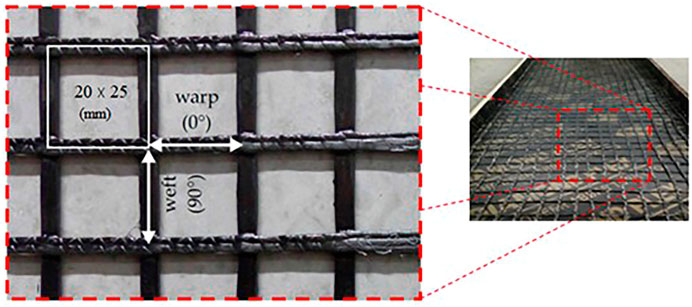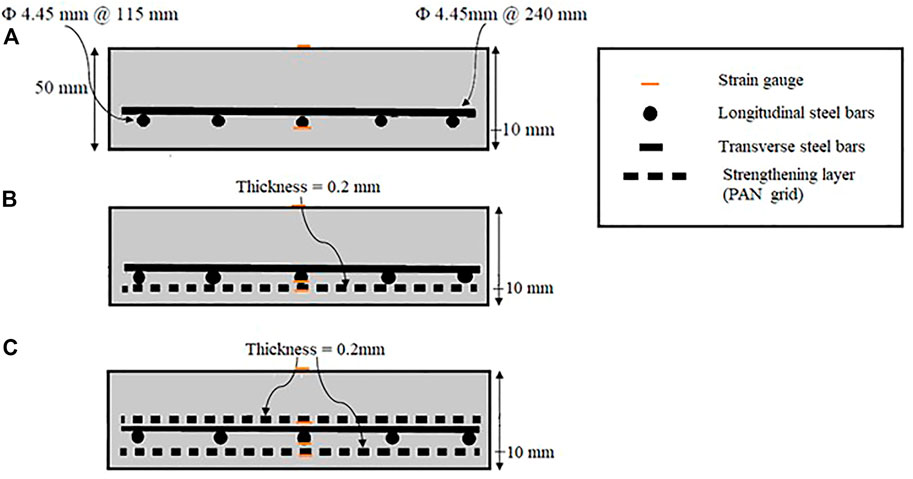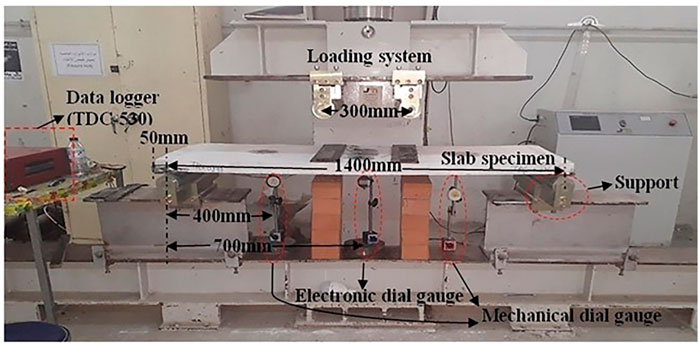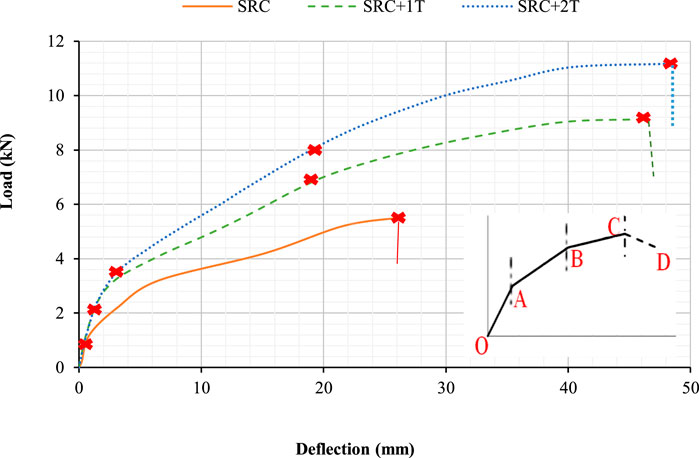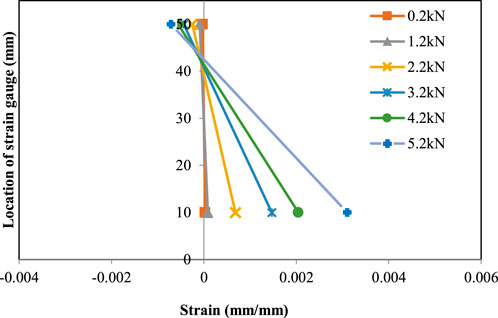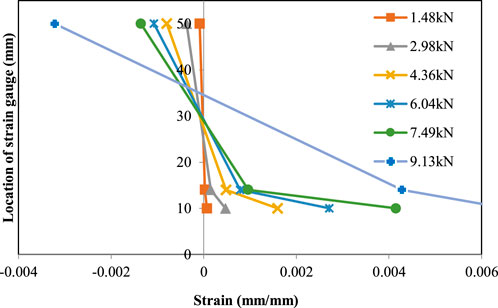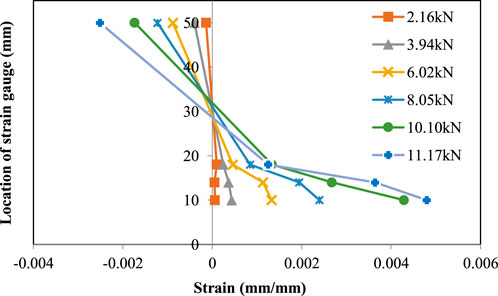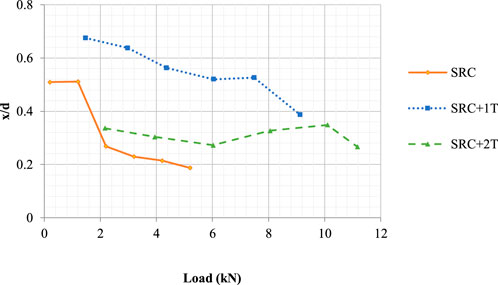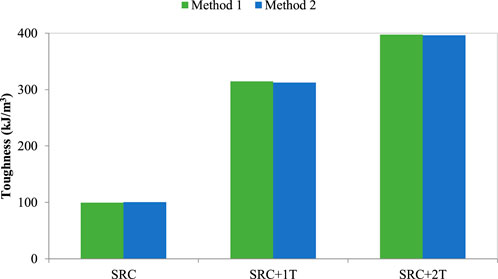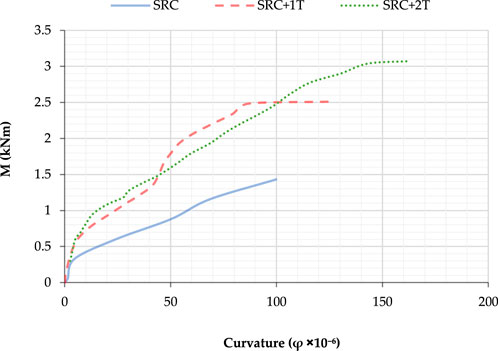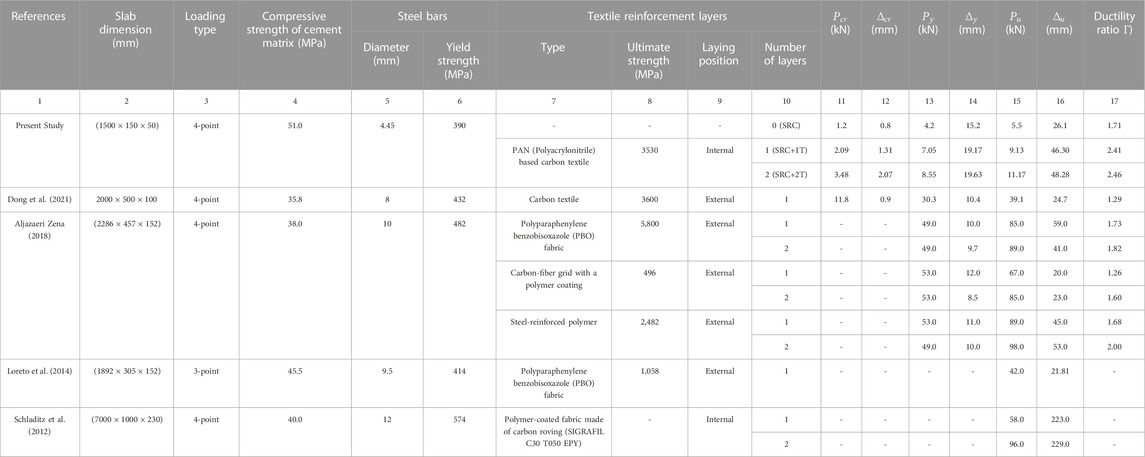Flexural behaviour of RC one-way slabs reinforced using PAN based carbon textile grid
- 1Department of Civil Engineering, College of Engineering, University of Diyala, Baqubah, Iraq
- 2Civil Engineering Section, University Polytechnic, New Delhi, India
- 3Department of Civil Engineering, College of Engineering, University of Duhok, Duhok, Iraq
- 4Department of Civil Engineering, College of Engineering, Nawroz University, Duhok, Iraq
- 5Department of Civil Engineering, Zakir Husain Engineering College, Aligarh Muslim University, Aligarh, India
- 6Department of Civil Engineering, Faculty of Engineering, Necmettin Erbakan University, Konya, Turkey
- 7Peter the Great St. Petersburg Polytechnic University, St Petersburg, Russia
Textile reinforced mortar (TRM) is mainly used for strengthening of existing structural members whereas, on the other hand Textile reinforced concrete (TRC) is a technology implied in construction of new members for enhancing the structural behaviour. Application of TRM on the tension zone of the reinforced concrete (RC) slabs to improve the flexural capacity has been investigated by many researchers in the past. However, the effectiveness of textile fabrics, used as internal reinforcement in the RC slab (TRC technology) needs to be studied. The paper, therefore, presents the experimental research conducted on three one-way RC slabs specimens reinforced using textile grid. An innovative Polyacrylonitrile (PAN) based carbon textile grid was used as internal reinforcement in combination with the steel bars. Two textile-reinforced RC slabs having one and two layers of textile grid (SRC + 1T and SRC + 2T respectively) and one reference slab (SRC) was fabricated to investigate the flexural behaviour under a four-point loading system. The internal textile reinforcement layer(s) was confirmed to be effective, particularly in terms of improving the cracking load, ductility, deformability and toughness. The material ductility of SRC + 1T and SRC + 2T slabs were increased by 41% and 44% compared to SRC slab. Also, the deformability ratio was found to be greater than 4, indicating a ductile failure of textile-reinforced slabs. Further, based on the load-deflection relation, moment-curvature curves were derived. Moreover, these curves were also developed using Eurocode two prediction model. The experimental and the predicted moment-curvature curves showed good agreement.
1 Introduction
The strengthening and retrofitting of existing structures as well as the search for innovative construction technologies yielding enhanced strength have been a major concern for engineers in recent years. There are various reasons for this, such as structural insufficiency, deficient concrete, great incoming loads and sometimes complying with the new standards (Aljazaeri Zena, 2018; Saeed et al., 2022b; Zeybek et al., 2022). Several strengthening composites and systems ranging from engineered cementitious composites (ECC), fibre reinforced polymers (FRP), textile reinforced mortar (TRM) and steel reinforced grout (SRG) have emerged for upgrading the civil engineering structures (Xie et al., 2022; Liu et al., 2023; Sadrolodabaee et al., 2023). Among these TRM gained great recognition as strengthening material for existing structures. Based on a similar approach Textile reinforced concrete (TRC) was developed and emerged to be an innovative construction technique for new age buildings. TRM is mainly used for strengthening of existing structural members whereas, on the other hand TRC is a technology implied for new structural members for enhanced structural behaviour (Taerwe and Matthys, 2013; Dong et al., 2021; Dong et al., 2022).
TRC is “a unique composite material made by inserting continuous textile fabric with fine-grained concrete, which is composed of a cement binder and fine particles. Textile reinforcement materials are made up of continuous length yarns, which are made up of hundreds, thousands, or tens of thousands of filaments. The filaments in the yarn are classified as exterior (sleeve) and internal (core). Because the sleeve filaments are only in full interface with the surrounding matrix, tensile stresses are transferred from the matrix to the yarn sleeve filaments through adhesive, while the core filaments, which are in less contact with the matrix, act on friction” (Hussein et al., 2022). TRC are well suited for situations where strain hardening is necessary, and steel reinforcing can be omitted, or for buildings exposed to seismic stresses and requiring high ductility (Torres et al., 2015; Saeed et al., 2022a; Qaidi et al., 2022b).
In international literature, there are a substantial amount of research articles on the strengthening effect of TRM in reinforced concrete (RC) beams (Loreto et al., 2015; Qaidi et al., 2022a; Bencardino and Nisticò, 2022). Loreto et al. (2015) evaluated the performance of RC beams strengthened using Fabric reinforced cementitious matrix (FRCM) in shear zone in the form of U-wraps. The experimental and analytical results indicated that increase in the shear capacity of the FRCM strengthened beam was not proportionally to the number of placed fabric layers and FRCM failure modes were found to be dependent on the amount of external reinforcement. Similarly, Bencardino and Nisticò (2022) also investigated the behaviour of different Steel-FRCM beams in direct shear and flexure. Two different unidirectional steel fibres were used namely, stainless steel and galvanized high strength steel. Debonding between the matrix–fibre interface (mode C) and Steel-FRCM composite (mode B) was witnessed, confirming the non-involvement of the concrete substrates. Ombres (2011) reported an increase in bearing capacity of RC beams strengthened using one to three layers of PBO (Polypara-phenylene-benzo-bisthiazole) fabric mesh by 16%, 33% and 40% respectively, compared to an un-strengthened RC beam. Ebead et al. (2019) observed that RC beams strengthened using one or two layers of PBO fabric failed to fabric slippage whereas, failed due to delamination of layers when three layers of strengthening were adopted. This similar phenomenon was also observed by Elsanadedy et al. (2013); Bencardino and Nisticò (2022). Besides Elsanadedy et al. (2013) also compared the ductility response of FRP and TRM (basalt-based textile) strengthened RC beams wherein the ductility of TRM strengthened beam was found to be superior to the FRP strengthened beam. Therefore, strengthening of RC beams using different types of textile reinforcement systems has shown a potential enhancement in flexural capacity accompanied by a reduction in deflection magnitude as well as crack width (Bencardino and Nisticò, 2022).
Consequently, research on the strengthening of RC slabs using the TRM, are rather limited in the open literature (Loreto et al., 2014; Koutas and Bournas, 2017; Althoey et al., 2022; Çelik et al., 2022). Loreto et al. (2014) studied the behavior of an RC slab with an externally reinforced fabric (PBO) reinforced cementitious matrix layer on the tension face. When the number of fabric layers was increased, the load capacity of the slab improved. TRM (uncoated/dry carbon and glass fiber rovings) strengthening of two-way slab enhanced pre-cracking and post-cracking stiffness, as well as cracking load, according to Koutas and Bournas (2017); Zhang et al. (2022) investigated the flexural behavior of one-way RC slabs reinforced with textile-reinforced geopolymer mortar (TRGM) and textile-reinforced polymer mortar (TRPM). The findings revealed that TRGM reinforced slabs had greater flexural capacity and better fracture control than TRPM strengthened slabs. Furthermore, it was discovered that increasing the number of layers and lowering the gap between the lateral textiles increased the flexural capacity of slabs (Papanicolaou et al., 2009; Ahmed et al., 2021; Tayeh et al., 2022; Unis Ahmed et al., 2022).
And only one research article has been reported till date on the manufacturing of one-way RC slabs using TRC technology (Schladitz et al., 2012). Schladitz et al. (2012) found that one-way RC slabs reinforced with one to four layers of Polymer-coated fabric composed of carbon rovings had a considerable improvement in load-bearing capacity and a reduction in slab deflection when compared to a reference RC slab with no textile layer.
Despite the available research findings on TRC slabs, experimental investigation considering different combinations of textile and the cementitious matrix is further required. The objective of the present study is to investigate the four-point flexural bending behaviour of textile reinforced RC slab with a thickness of 50 mm, having one and two internal layers of an innovative Polyacrylonitrile (PAN) based carbon textile grid. An extensive discussion of results has been presented in terms of; load-deflection curve, failure mode, cracking pattern, strain profile and moment-curvature relation of the slabs. A total of three one-way slabs were fabricated; reference/steel reinforced concrete (SRC) slab having only steel reinforcement, steel reinforced concrete slab having one layer of textile grid (SRC + 1T) and steel reinforced concrete slab having two layers of textile grid (SRC + 2T).
2 Experimental study
2.1 Materials
Fine grain concrete was prepared using Iraqi Portland cement (Grade-43) confirming the Iraqi specification (Specification I. S., 1984), and fine anti-slip sand having a maximum size of 1.18 mm, graded as per (Specification I., 1984) was used. The average cylinder compressive strength, split tensile strength and modulus of elasticity were experimentally determined in the laboratory according to ASTM C-496 (Designation, 1996). The corresponding values 51 MPa, 4.14 MPa and 31528 MPa were observed.
The primary and secondary steel reinforcing bars were both deformed and hot-rolled to 4.45 mm in diameter. According to ASTM A615 (American Society for Testing and Materials (ASTM), 2000), the average yield strength was 390 MPa, the yield strain was 0.002, the ultimate strength was 464.7 MPa, and the modulus of elasticity was 195000 MPa.
A woven and balanced PAN based carbon textile grid (as shown in Figure 1) was used in this study. The mechanical properties of the PAN textile provided by the manufacturer (Jiaxing Newtex Composites) are summarized in Table 1. The nominal size of the PAN grids was 20
For enhancing the bond between the cement matrix and PAN grid, a special mortar was used to cast the textile-reinforced slabs having one and two layers of PAN textile. The mortar matrix consists of Portland cement (PC-43), fine anti-slip sand (max. size
2.2 Preparation of test specimen
Herein, three slabs having dimensions 1,500
2.3 Test setup
The flexural behaviour of three slab specimens was verified using a four-point bending test in the department of Civil engineering, College of Engineering, Diyala University, Iraq. The test setup is as shown in Figure 3. Each slab specimen was placed simply supported over a clear span of 1,400 mm with a 50 mm overhang on both ends. Two concentrated loads 300 mm apart were applied at the mid span of the slab through a hydraulic system. The deflection of the slab was measured using three dial gauges. An electronic dial gauge was placed under the mid span of the slab. The other two mechanical dial gauges were placed under the slab at a distance of 400 mm from each support. The embedded strain gauges were connected to a Data logger (TDC-530) to measure the corresponding strain in the PAN grid, steel reinforcement and concrete. The load was applied and the readings for the strain and deflection were reported for every 0.1–1 kN increment. Upon the failure of the specimen, the crack width was measured using a micro crack meter.
3 Discussion of the experimental results
The results pertaining to the flexural behaviour of slabs; SRC, SRC + 1T and SRC + 2T subjected to a four-point bending test have been summarized in Table A1 in appendix. Also, the results have been compared with the similar studies existing in literature.
3.1 Load-deflection curve
Figure 4 depicts the load-deflection curve for the three tested slab specimens. For describing the flexural behaviour of the slabs, the load-deflection curve has been divided into four regions: uncracked (OA), crack development (AB), crack stabilization (BC) and fully cracked/failure (CD). The values of the characteristic points: cracking, yield and ultimate are summarized and compared with the existing studies in Table A1 (Col. 11–17).
The region OA clear indicates the elastic region where load and deflection linearly increase to arrive at the cracking point. This region is principally governed by the stiffness of the concrete matrix. In slab SRC the first cracking was observed at 1.2 kN load
3.2 Cracking pattern and mode of failure
Table 2 illustrates the crack details for the three tested slabs. The cracking load to the ultimate load ratio
Further, to have an insight into the mode of failure in the slab specimen, two parameters are of interest: deformability factor and ductility ratio. The deformability factor, according to the Canadian Standards Association (Association, 2012), is the product of the strength and deflection factors provided by Eqs 1, 2:
where
Further, the member ductility ratio is calculated from the following relation given in Eq. 3:
Concerning,
3.3 Strain profile at mid span
The strain gauge readings of the slabs; SRC, SRC + 1T, and SRC + 2T were shown at various load levels in Figures 6–8 based on data logger observations. During the elastic state, the change in strain in relation to the position of the gauge was found to be linear. However, after cracking, the tension in the textile layer increased rapidly. Also, as seen in Figure 9, the depth of the compression zone (x/d) decreases fast with increasing load, which may be ascribed to the steel reinforcement’s steadily developing strain. In the case of SRC + 1T and SRC + 2T, however, the curves decrease more slowly than the SRC curve. This illustrates the nature of the textile reinforcement’s contribution to stress bearing (Akeed et al., 2022; Al-Tayeb et al., 2022; Almeshal et al., 2022). This cooperative contribution seems to be uniform in the case of SRC + 2T, which may explain for its larger textile reinforcement ratio as compared to SRC + 1T.
3.4 Toughness
Material toughness can be defined as the ability of the material to absorb energy in the plastic region. The area under the force-deformation curve or the stress-strain curve of the tested specimen under flexure is denoted as the toughness of the material. Mathematically, it can be defined as in Eq. 4.
This area
3.5 Experimental moment-curvature relation
For the slab specimen subjected to four-point bending test (refer, Figure 11), the forces responsible for maximum bending moment will be; the self-weight of the slab (concrete + steel + strengthening) and the incoming external load P). Therefore, the equation for maximum flexural moment is given by [refer, Eq. 5],
The notations used in Eq. (5) are indicated in Figure 11. Wp and WRC are the self-weight of PAN grid and RC slab respectively. These self-weights are computed as a line load (Schladitz et al., 2012) and, moment was calculated for different magnitudes of load acting on the slab. The density of concrete was assumed as 25 kN/m3.
The curvature at each load is derived from the equilibrium and strain compatibility equation (Torres et al., 2015) and is given as in Eq. 6,
where d is the effective depth of the section (here, d = 40 mm),
The moment curvature plot obtained from the experimental observations has been plotted in Figure 12. The curvature of the three-slab specimen remained comparable till 0.33 kNm, which is also the experimental cracking moment
3.6 Predicted moment-curvature relation
EN 1992-1-1 (generally referred as Eurocode 2 (Institution, 2004)) deals with the rules and concepts required for designing concrete, reinforced concrete and prestressed concrete structures. Suitability of moment curvature prediction using Eurocode 2 has been widely accepted (Torres et al., 2015) for steel reinforced concrete and fibre reinforced concrete elements. Eurocode two interpolates the moment curvature between the fully cracked and uncracked states, classically represented as in Figure 13. The bending and deformation behaviour of reinforced concrete typically has two states: state 1, uncracked and, state 2, fully cracked. The state one is governed by the linear elastic behaviour in both concrete and reinforcement. While, state 2, exhibits a nonlinear behaviour where, the reinforcement takes up all the tensile stresses acting on the member after cracking.
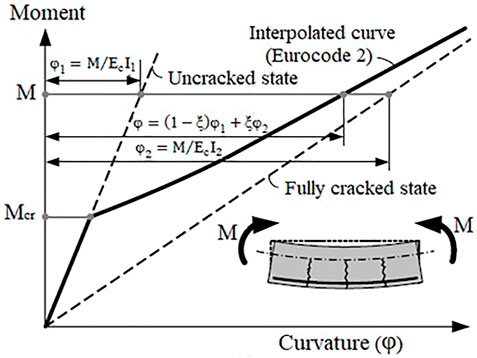
FIGURE 13. Moment-curvature relation as per Eurocode 2 (redrawn from (Institution, 2004)).
The following Eq. 7 expresses the average curvature as:
Here,
The
Further, using the classical relation of ‘strength of materials’, the curvature
Here,
The cracking moment of the reinforced concrete section is given as:
In Eq. 10,
where
On the other hand, the equivalent moment of inertia for the cracked section derived using inverse relation (Torres et al., 2015) is given in Eq. 12,
where d and b are the effective depth and width of the cross-section. Ratio
The above Eq. 13 indicates that
where
where x represents the depth of neutral axis for the fully cracked section and, ƞ denotes the modular ratio of the modulus of elasticity of the bare bar and concrete. Consequently, the ratio
The moment curvature curve for the uncracked state, fully cracked states and the interpolated curve (as per (Institution, 2004)) has been plotted in Figure 14. The experimental and Eurocode two curve have also been compared. For slab SRC and SRC + 2T (refer, Figures 13A, C), corresponding to 1kNm moment, the experimental and predicted (Eurocode 2) curvatures were found to be equivalent
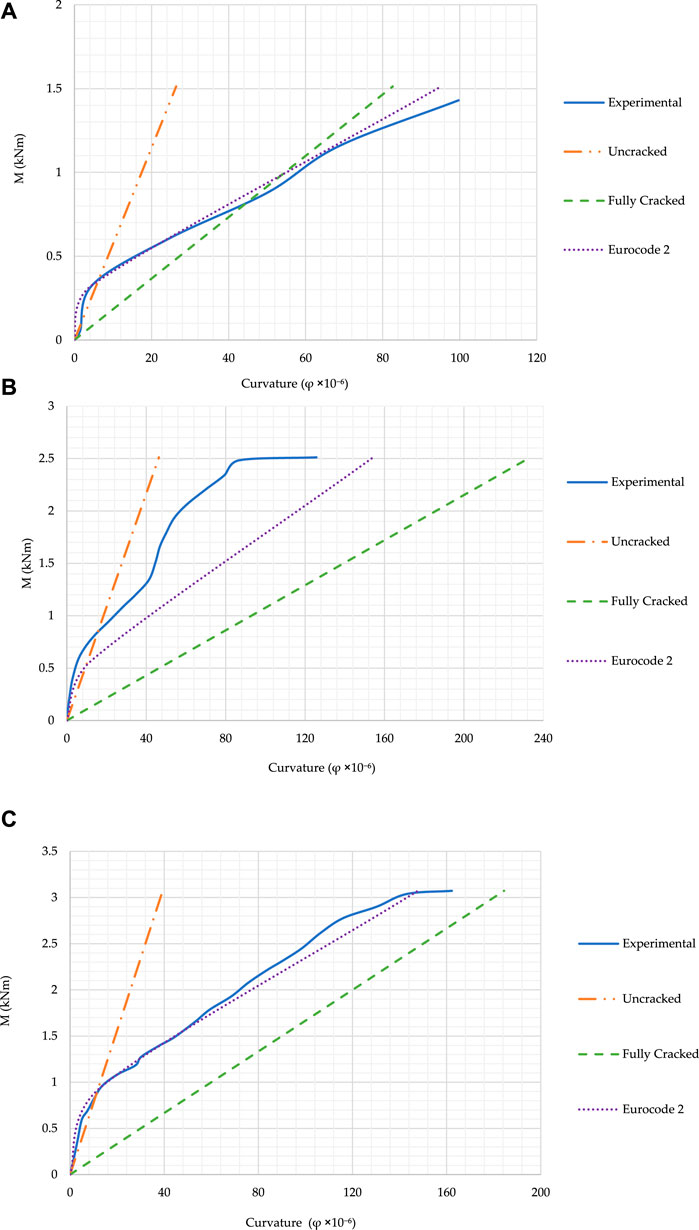
FIGURE. 14. Comparison of experimental and predicted moment-curvature curve for (A) SRC (B) SRC + 1T (C) SRC + 2T.
4 Conclusion
In the present study three slabs, reference slab SRC and two textile reinforced slabs having one (SRC + 1T) and two (SRC + 2T) textile layers placed internally with the concrete matrix were tested under four-point flexure machine. The effect of the improved textile reinforced RC slabs has been discussed in terms of load-deflection curve, cracking pattern, failure mode, strain profile, moment curvature relation and toughness with respect to the reference slab. Also, based on the test results, the moment-curvature relation was developed and compared with the predicted curve derived using Eurocode 2. The following conclusions have been summarized below.
• The textile reinforcing layer has shown to be effective, especially in terms of increasing cracking load. The load capacity of the textile reinforced slabs at the cracking, yield, and ultimate points was increased by 74%, 68%, and 66%, respectively, in SRC + 1T, and by 190%, 104%, and 103%, respectively, in SRC+2T.
• The mid span deflections of the textile-reinforced slabs were enhanced by 64–159% at the cracking point and, deflection at ultimate point were increased by 77–85%. On the other hand, at the yield point, the mid span deflections were approximately at the same level.
• The spacing between the two closest cracks in SRC was found to be 30 mm whereas; in case of SRC + 1T and SRC + 2T it was 20 mm and 10 mm respectively. Also, the widths of the crack were found to be ∼0.340 mm, ∼0.241 mm and ∼0.238 mm respectively.
• The addition of textile reinforcement has been confirmed to be efficient by improving the material ductility of SRC + 1T and SRC + 2T slabs by 41% and 44%. Also, the deformability ratio was found to be greater than 4, indicating a ductile failure of textile-reinforced slabs. Moreover, textile reinforcement enhanced the toughness by 210% and 293% respectively compared to SRC.
• Based on the obtained load-deflection relation and strain values, moment-curvature curve was developed. A predicted curve based on the formulation of Eurocode two was also evaluated. In all the three slabs a good agreement was exhibited between the experiment and predicted curve.
Data availability statement
The original contributions presented in the study are included in the article/supplementary material, further inquiries can be directed to the corresponding authors.
Author contributions
Conceptualization, SS, OH, AI, SA, SQ, HN, YÖ, and MS; methodology, OH, AI, SA, HN, YÖ, MS; software, SS OH, AI, SQ, SA, HN, YÖ, and MS; validation, OH, AI, SS, SA, HN, YÖ, and MS; formal analysis, SS, OH, AI, SA, HN, and MS; investigation, OH, AI, SA, HN, YÖ, and MS; resources, OH, AI, SA, HN, YÖ, and MS; data curation, SS, OH, AI, SA, HN, YÖ, and MS; writing—original draft preparation, OH, AI, and SA; writing—review and editing, OH, AI, SA, HN, YÖ, MS, and SS; visualization, OH, AI, SA, HN, YÖ, MS, and SQ; supervision, AI and SA; project administration, MS; funding acquisition, MS. All authors have read and agreed to the published version of the manuscript.
Funding
The research is partially funded by the Ministry of Science and Higher Education of the Russian Federation under the strategic academic leadership program ‘Priority 2030’ (Agreement 075-15-2021-1333 dated 30 September 2021).
Acknowledgments
The authors extend their thanks to the Ministry of Science and Higher Edu-cation of the Russian Federation for funding this work.
Conflict of interest
The authors declare that the research was conducted in the absence of any commercial or financial relationships that could be construed as a potential conflict of interest.
Publisher’s note
All claims expressed in this article are solely those of the authors and do not necessarily represent those of their affiliated organizations, or those of the publisher, the editors and the reviewers. Any product that may be evaluated in this article, or claim that may be made by its manufacturer, is not guaranteed or endorsed by the publisher.
References
Ahmed, H. U., Mohammed, A. A., Rafiq, S., Mohammed, A. S., Mosavi, A., Sor, N. H., et al. (2021). Compressive strength of sustainable geopolymer concrete composites: A state-of-the-art review. Sustainability 13, 13502. doi:10.3390/su132413502
Akeed, M. H., Qaidi, S., Ahmed, H. U., Faraj, R. H., Mohammed, A. S., Emad, W., et al. (2022). Ultra-high-performance fiber-reinforced concrete. Part IV: Durability properties, cost assessment, applications, and challenges. Case Stud. Constr. Mater. 17, 1271. doi:10.1016/j.cscm.2022.e01271
Al-Tayeb, M. M., Aisheh, Y. I. A., Qaidi, S. M. A., and Tayeh, B. A. (2022). Experimental and simulation study on the impact resistance of concrete to replace high amounts of fine aggregate with plastic waste. Case Stud. Constr. Mater. 17, 1324. doi:10.1016/j.cscm.2022.e01324
Aljazaeri Zena, R. (2018). Flexure performance of RC one-way slabs strengthened with composite materials. American Society of Civil Engineers. Virginia, USA,
Almeshal, I., Al-Tayeb, M. M., Qaidi, S. M. A., Abu Bakar, B. H., and Tayeh, B. A. (2022). Mechanical properties of eco-friendly cements-based glass powder in aggressive medium. Mater. Today Proc. 58, 1582–1587. doi:10.1016/j.matpr.2022.03.613
Althoey, F., Hakeem, I. Y., Hosen, M. A., Qaidi, S., Isleem, H. F., Hadidi, H., et al. (2022). Behavior of concrete reinforced with date palm fibers. Materials 15, 7923. doi:10.3390/ma15227923
American Society for Testing and Materials (ASTM) (2000). Standard specification for deformed and plain billet-steel bars for concrete reinforcement. ASTM, Pennsylvania, PA, USA.
Association, C. S. (2012). Design and construction of building structures with fibre-reinforced polymers. Toronto, Canada: Canadian Standards Association.
Bencardino, F., and Nisticò, M. (2022). Evaluation of the maximum strain for different steel-FRCM systems in RC beams strengthened in flexure. Fibers 10, 67. doi:10.3390/fib10080067
Carneiro, J., Jalali, S., Teixeira, V., and Tomas, M. (2005). The effect of concrete strength and reinforcement on toughness of reinforced concrete beams. Constr. Build. Mater. 19, 493–499. doi:10.1016/j.conbuildmat.2005.01.008
Çelik, A. İ., Özkılıç, Y. O., Zeybek, Ö., Karalar, M., Qaidi, S., Ahmad, J., et al. (2022). Mechanical behavior of crushed waste glass as replacement of aggregates. Materials 15, 8093. doi:10.3390/ma15228093
Designation, A. (1996)., 4. Pennsylvania, PA, USA: Annual Book of ASTM Standards, American Society for Testing and Material, 1–4.C496-96 Stand. Specif. splitting tensile strength Cylind. Concr. specimens.
Dong, Z., Dai, J., Deng, M., and Wu, Z. (2022). Experimental study on the mechanical properties of textile reinforced mortar (TRM) composites with different yarn shapes subjected to uniaxial tension. Archives Civ. Mech. Eng. 22, 185. doi:10.1007/s43452-022-00494-6
Dong, Z., Deng, M., Dai, J., and Song, S. (2021). Flexural strengthening of RC slabs using textile reinforced mortar improved with short PVA fibers. Constr. Build. Mater. 304, 124613. doi:10.1016/j.conbuildmat.2021.124613
Ebead, U., El Refai, A., Shrestha, K., and Nanni, A. (2019). Soffit and U-Wrap fabric-reinforced cementitious matrix strengthening for reinforced concrete beams. ACI Struct. J. 116, 267–278.
Elsanadedy, H. M., Almusallam, T. H., Alsayed, S. H., and Al-Salloum, Y. A. (2013). Flexural strengthening of RC beams using textile reinforced mortar–Experimental and numerical study. Compos. Struct. 97, 40–55. doi:10.1016/j.compstruct.2012.09.053
Emad, W., Mohammed, A. S., Bras, A., Asteris, P. G., Kurda, R., Muhammed, Z., et al. (2022). Metamodel techniques to estimate the compressive strength of UHPFRC using various mix proportions and a high range of curing temperatures. Constr. Build. Mater. 349, 128737. doi:10.1016/j.conbuildmat.2022.128737
Faraj, R. H., Ahmed, H. U., Rafiq, S., Sor, N. H., Ibrahim, D. F., and Qaidi, S. M. A. (2022). Performance of self-compacting mortars modified with nanoparticles: A systematic review and modeling. Clean. Mater. 4, 100086. doi:10.1016/j.clema.2022.100086
Hussein, O. H., Ibrahim, A. M., Abd, S. M., Najm, H. M., Shamim, S., and Sabri, M. M. S. (2022). Hybrid effect of steel bars and PAN textile reinforcement on ductility of one-way slab subjected to bending. Molecules 27, 5208. doi:10.3390/molecules27165208
Ibrahim, A. M., Abd, S. M., Hussein, O. H., Tayeh, B. A., Najm, H. M., and Qaidi, S. (2022). Influence of adding short carbon fibers on the flexural behavior of textile-reinforced concrete one-way slab. Case Stud. Constr. Mater. 17, 1601. doi:10.1016/j.cscm.2022.e01601
Institution, B. S. (2004). Eurocode 2: Design of concrete structures: Part 1-1: General rules and rules for buildings. London, UK: British Standards Institution.
Koutas, L. N., and Bournas, D. A. (2017). Flexural strengthening of two-way RC slabs with textile-reinforced mortar: Experimental investigation and design equations. J. Compos. Constr. 21, 4016065. doi:10.1061/(asce)cc.1943-5614.0000713
Liu, T., Gao, Y., Gao, X., Yao, Y., Lu, Y., and Fan, W. (2023). A systematic investigation for mode-I fracture properties of stitched composites. Int. J. Mech. Sci. 241, 107982. doi:10.1016/j.ijmecsci.2022.107982
Loreto, G., Babaeidarabad, S., Leardini, L., and Nanni, A. (2015). RC beams shear-strengthened with fabric-reinforced-cementitious-matrix (FRCM) composite. Int. J. Adv. Struct. Eng. (IJASE) 7, 341–352. doi:10.1007/s40091-015-0102-9
Loreto, G., Leardini, L., Arboleda, D., and Nanni, A. (2014). Performance of RC slab-type elements strengthened with fabric-reinforced cementitious-matrix composites. J. Compos. Constr. 18, 4013003. doi:10.1061/(asce)cc.1943-5614.0000415
Ombres, L. (2011). Flexural analysis of reinforced concrete beams strengthened with a cement based high strength composite material. Compos. Struct. 94, 143–155. doi:10.1016/j.compstruct.2011.07.008
Orosz, K., Blanksvärd, T., Täljsten, B., and Fischer, G. (2010). From material level to structural use of mineral-based composites—An overview. Adv. Civ. Eng. 2010, 1–19. doi:10.1155/2010/985843
Papanicolaou, C., Triantafillou, T., Papantoniou, I., and Balioukos, C. (2009). Strengthening of two-way reinforced concrete slabs with textile reinforced mortars. Dresden Germany: TRM).
Qaidi, S. M. A., Dinkha, Y. Z., Haido, J. H., Ali, M. H., and Tayeh, B. A. (2021). Engineering properties of sustainable green concrete incorporating eco-friendly aggregate of crumb rubber: A review. J. Clean. Prod. 324, 129251. doi:10.1016/j.jclepro.2021.129251
Qaidi, S. M. A., Mohammed, A. S., Ahmed, H. U., Faraj, R. H., Emad, W., Tayeh, B. A., et al. (2022d). Rubberized geopolymer composites: A comprehensive review. Ceram. Int. 48, 24234–24259. doi:10.1016/j.ceramint.2022.06.123
Qaidi, S. M. A., Sulaiman Atrushi, D., Mohammed, A. S., Unis Ahmed, H., Faraj, R. H., Emad, W., et al. (2022e). Ultra-high-performance geopolymer concrete: A review. Constr. Build. Mater. 346, 128495. doi:10.1016/j.conbuildmat.2022.128495
Qaidi, S. M. A., Tayeh, B. A., Ahmed, H. U., and Emad, W. (2022f). A review of the sustainable utilisation of red mud and fly ash for the production of geopolymer composites. Constr. Build. Mater. 350, 128892. doi:10.1016/j.conbuildmat.2022.128892
Qaidi, S. M. A., Tayeh, B. A., Isleem, H. F., De Azevedo, A. R. G., Ahmed, H. U., and Emad, W. (2022g). Sustainable utilization of red mud waste (bauxite residue) and slag for the production of geopolymer composites: A review. Case Stud. Constr. Mater. 16, 994. doi:10.1016/j.cscm.2022.e00994
Qaidi, S., Najm, H. M., Abed, S. M., Ahmed, H. U., Al Dughaishi, H., Al Lawati, J., et al. (2022a). Fly ash-based geopolymer composites: A review of the compressive strength and microstructure analysis. Materials 15, 7098. doi:10.3390/ma15207098
Qaidi, S., Najm, H. M., Abed, S. M., Özkılıç, Y. O., Al Dughaishi, H., Alosta, M., et al. (2022b). Concrete containing waste glass as an environmentally friendly aggregate: A review on fresh and mechanical characteristics. Materials 15, 6222. doi:10.3390/ma15186222
Qaidi, S., Yahia, A., Tayeh, B. A., Unis, H., Faraj, R., and Mohammed, A. (2022c). 3D printed geopolymer composites: A review. Mater. Today Sustain. 20, 100240. doi:10.1016/j.mtsust.2022.100240
Sadrolodabaee, P., Claramunt, J., Ardanuy, M., and De La Fuente, A. (2023). Effect of accelerated aging and silica fume addition on the mechanical and microstructural properties of hybrid textile waste-flax fabric-reinforced cement composites. Cem. Concr. Compos. 135, 104829. doi:10.1016/j.cemconcomp.2022.104829
Saeed, A., Najm, H. M., Hassan, A., Qaidi, S., Sabri, M. M. S., and Mashaan, N. S. (2022a). A comprehensive study on the effect of regular and staggered openings on the seismic performance of shear walls. Buildings 12, 1293. doi:10.3390/buildings12091293
Saeed, A., Najm, H. M., Hassan, A., Sabri, M. M. S., Qaidi, S., Mashaan, N. S., et al. (2022b). Properties and applications of geopolymer composites: A review study of mechanical and microstructural properties. Materials 15, 8250. doi:10.3390/ma15228250
Schladitz, F., Frenzel, M., Ehlig, D., and Curbach, M. (2012). Bending load capacity of reinforced concrete slabs strengthened with textile reinforced concrete. Eng. Struct. 40, 317–326. doi:10.1016/j.engstruct.2012.02.029
Specification, I. (1984a). Aggregates from natural sources for concrete and construction. Baghdad, Iraq: Central Organization for Standardization and Quality Control COSQC.
Specification, I. S. (1984b). Portland cement. Baghdad, Iraq: Central Organization for Standardization and Quality Control COSQC.
Taerwe, L., and Matthys, S. (2013). Fib model code for concrete structures 2010. Ernst and Sohn, Wiley. New Jersey, NJ, USA.
Tayeh, B. A., Akeed, M. H., Qaidi, S., and Bakar, B. H. A. (2022). Influence of the proportion of materials on the rheology and mechanical strength of ultrahigh-performance concrete. Case Stud. Constr. Mater. 17, 1433. doi:10.1016/j.cscm.2022.e01433
Torres, L., Barris, C., Kaklauskas, G., and Gribniak, V. (2015). Modelling of tension-stiffening in bending RC elements based on equivalent stiffness of the rebar. Struct. Eng. Mech. 53, 997–1016. doi:10.12989/sem.2015.53.5.997
Unis Ahmed, H., Mahmood, L. J., Muhammad, M. A., Faraj, R. H., Qaidi, S. M. A., Hamah Sor, N., et al. (2022). Geopolymer concrete as a cleaner construction material: An overview on materials and structural performances. Clean. Mater. 5, 100111. doi:10.1016/j.clema.2022.100111
Williams Portal, N., Nyholm Thrane, L., and Lundgren, K. (2017). Flexural behaviour of textile reinforced concrete composites: Experimental and numerical evaluation. Mater. Struct. 50, 4–14. doi:10.1617/s11527-016-0882-9
Xie, J., Guo, Z., Shao, M., Zhu, W., Jiao, W., Yang, Z., et al. (2022). Mechanics of textiles used as composite preforms: a review. Composite Structures, 116401. 304, doi:10.1016/j.compstruct.2022.116401
Yang, J., Guo, Y., Shen, A., Chen, Z., Qin, X., and Zhao, M. (2019). Research on drying shrinkage deformation and cracking risk of pavement concrete internally cured by SAPs. Constr. Build. Mater. 227, 116705. doi:10.1016/j.conbuildmat.2019.116705
Yin, S., Xu, S., and Lv, H. (2014). Flexural behavior of reinforced concrete beams with TRC tension zone cover. J. Mater. Civ. Eng. 26, 320–330. doi:10.1061/(asce)mt.1943-5533.0000811
Zeybek, Ö., Özkılıç, Y. O., Karalar, M., Çelik, A. İ., Qaidi, S., Ahmad, J., et al. (2022). Influence of replacing cement with waste glass on mechanical properties of concrete. Materials 15, 7513. doi:10.3390/ma15217513
Zhang, H. Y., Liu, H. Y., Kodur, V., Li, M. Y., and Zhou, Y. (2022). Flexural behavior of concrete slabs strengthened with textile reinforced geopolymer mortar. Compos. Struct. 284, 115220. doi:10.1016/j.compstruct.2022.115220
Appendix
Keywords: RC slab, textile reinforcement, cracking load, ductility, deformability, momentcurvature curve
Citation: Abd SM, Ibrahim AM, Hussein OH, Shamim S, Qaidi S, Najm HM, Özkılıç YO and Sabri Sabri MM (2023) Flexural behaviour of RC one-way slabs reinforced using PAN based carbon textile grid. Front. Mater. 10:1070457. doi: 10.3389/fmats.2023.1070457
Received: 14 October 2022; Accepted: 09 January 2023;
Published: 20 January 2023.
Edited by:
Chaoyu Chen, Jiangnan University, ChinaReviewed by:
Francesco Bencardino, University of Calabria, ItalyTao Liu, Xi’an Polytechnic University, China
Zhifang Dong, Xi’an University of Architecture and Technology, China
Copyright © 2023 Abd, Ibrahim, Hussein, Shamim, Qaidi, Najm, Özkılıç and Sabri Sabri. This is an open-access article distributed under the terms of the Creative Commons Attribution License (CC BY). The use, distribution or reproduction in other forums is permitted, provided the original author(s) and the copyright owner(s) are credited and that the original publication in this journal is cited, in accordance with accepted academic practice. No use, distribution or reproduction is permitted which does not comply with these terms.
*Correspondence: Omar H. Hussein, ekhel199276@gmail.com; Shaker Qaidi, shaker.abdal@uod.ac
 Suhad M. Abd1
Suhad M. Abd1  Omar H. Hussein
Omar H. Hussein Shaker Qaidi
Shaker Qaidi Hadee Mohammed Najm
Hadee Mohammed Najm Mohanad Muayad Sabri Sabri
Mohanad Muayad Sabri Sabri